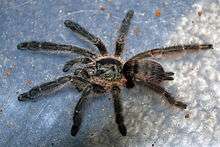Tapinauchenius
| Tapinauchenius | |
|---|---|
 | |
| Tapinauchenius cupreus | |
 | |
| Tapinauchenius elenae spiderling | |
| Scientific classification | |
| Kingdom: | Animalia |
| Phylum: | Arthropoda |
| Subphylum: | Chelicerata |
| Class: | Arachnida |
| Order: | Araneae |
| Infraorder: | Mygalomorphae |
| Family: | Theraphosidae |
| Genus: | Tapinauchenius Ausserer, 1871[1] |
Tapinauchenius is a genus of spiders in the family Theraphosidae (tarantulas). It is native to South America and the Antilles.[1]
Description
Tapinauchenius are relatively small when compared to the similar genus Pslamopoeus, reaching 5 inches on average. Like Psalmopues, they also lack urticating hairs and are arboreal, often found in tree cavities. This genus is well known by hobbyists for their incredible speed and striking coloration, eggsacs often contain 100-200 spiderlings.
Taxonomy
The genus Tapinauchenius was erected by Anton Ausserer in 1871 for the species Tapinauchenius plumipes, first described by Koch in 1842 in the genus Mygale and then moved by him to the genus Eurypelma.[1][2] The name is derived from the Greek ταπεινός, 'low', and αὐχήν, 'neck'.[2]
Species
As of May 2016, the World Spider Catalog accepted the following species:[1]
- Tapinauchenius brunneus Schmidt, 1995 – Brazil
- Tapinauchenius concolor (Caporiacco, 1947) – Guyana
- Tapinauchenius cupreus Schmidt & Bauer, 1996 – Ecuador
- Tapinauchenius elenae Schmidt, 1994 – Ecuador
- Tapinauchenius gigas Caporiacco, 1954 – French Guiana
- Tapinauchenius latipes L. Koch, 1875 – Venezuela
- Tapinauchenius plumipes (C. L. Koch, 1842) (type species) – Suriname
- Tapinauchenius sanctivincenti (Walckenaer, 1837) – St. Vincent
- Tapinauchenius subcaeruleus Bauer & Antonelli, 1997 – Ecuador
- Tapinauchenius violaceus (Mello-Leitão, 1930) (syn. T. purpureus) – French Guiana, Brazil
References
- 1 2 3 4 "Gen. Tapinauchenius Ausserer, 1871". World Spider Catalog. Natural History Museum Bern. Retrieved 2016-05-26.
- 1 2 Ausserer, Anton (1871). Beiträge zur Kenntniss der Arachniden-Familie der Territelariae Thorell (Mygalidae Autor) (in German). Vienna: Überreuter. p. 201. Retrieved 22 February 2013.